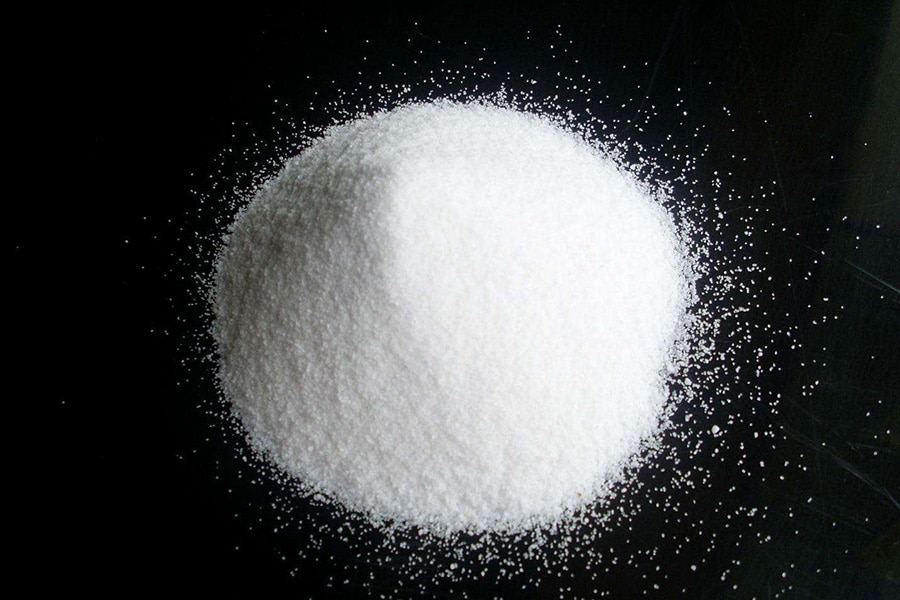Silica fume hoặc microsilica
Silica fume Là một vật liệu vô định hình không thể hiện thứ tự tầm xa của một tinh thể. Nó là một sản phẩm phụ thu được bên trong các lò hồ quang điện được sử dụng để sản xuất kim loại silicon và silicon ferro. Là một pozzolanic cực kỳ mịn màng, Nó có kích thước hạt là 150nm. Độ mịn cực độ như vậy làm cho nó trở thành một thành phần lý tưởng cho bê tông. Bê tông xi măng Portland là ví dụ phổ biến nhất. Bê tông có silica fume như một thành phần được gắn kết hơn nhiều. Nhờ diện tích bề mặt rất cao của nó, Nó giúp giảm sử dụng nước trong khi chuẩn bị bê tông và cũng giảm chảy máu đến một mức độ lớn.
Metakaolin
Metakaolin, như tên cho thấy, được lấy từ kaolinite khoáng đất sét. Nó thường được sử dụng trong sản xuất sứ. Mặc dù kích thước hạt metakaolin nhỏ hơn bê tông, silica fume có kích thước tốt hơn nhiều. Như một dạng kaolinite được nung khan, Nó cung cấp một cường độ nén được cải thiện trong khi giảm tính thấm. Nó được sử dụng phổ biến trong bê tông hiệu suất cao, Xi măng sợi, cối, và vữa.
| Dự án | SiO₂,% | Al₂O₃,% | Fe₂O₃,% | CaO,% | MgO,% | Cl,% | Tổng độ kiềm,% | diện tích bề mặt cụ thể,㎡/g |
| Metakaolin | 54.66 | 40.19 | 0.84 | 0.12 | 0.084 | 0.0037 | 0.32 | 15.1 |
| Silica Fume | 94.48 | / | / | / | / | 0.013 | / | 19.32 |
Phân tích hóa học vật lý
So sánh sử dụng trong bê tông tro bay
Theo nghiên cứu, Nó đã được quan sát thấy rằng việc sử dụng silica fume trong bê tông tro bay làm giảm sự mở rộng trượt. Trong khi đó, metakaolin tăng mở rộng sự sụt giảm do đó cung cấp sức mạnh lâu dài. Phần mở rộng giảm cho silica fume chỉ là 360mm, Trong khi metakaolin thể hiện sự mở rộng giảm của 600Mn. Cả hai vật liệu đều cung cấp khả năng chống lại sự xâm nhập của clorua. Hệ số khuếch tán của ion clorua cho khói silica là 3.20, Trong khi giá trị hệ số cho metakaolin là 7.47.
So sánh các hiệu ứng đối với tính chất kỹ thuật của đất mở rộng
Đất mở rộng như Bentonite hoặc Montmorillonite được sử dụng để xây dựng một số cấu trúc trên khắp thế giới. Họ có xu hướng sưng hoặc co lại dựa trên sự sẵn có của lượng nước trong vùng lân cận của họ. Nó vẫn là một thực tế là các loại đất mở rộng thiệt hại nhiều nhà hơn so với lũ lụt và động đất kết hợp. Các cấu trúc làm từ đất mở rộng có thể phát triển các vết nứt và thiệt hại dựa trên sự giải quyết khác biệt của đất. Cả silica fume và metakaolin được sử dụng làm chất ổn định phụ gia để điều trị đất mở rộng. Các học Chuẩn bị hỗn hợp với nồng độ khác nhau của cả hai vật liệu. Việc bổ sung silica fume làm tăng giới hạn Atterberg cho hỗn hợp, Trong khi metakaolin giảm nó. Fume silica làm giảm trọng lượng riêng của hỗn hợp và metakaolin làm tăng nó. Và đồng bộ với những thay đổi này, Metakaolin tăng trọng lượng khô tối đa và giảm hàm lượng nước tối ưu của hỗn hợp. Các hiệu ứng là một tấm gương đối diện khi silica fume được thêm vào hỗn hợp.
So sánh các hiệu ứng trên các phản ứng kiềm-silica
Khả năng phản ứng cao metakaolin và khói silica là nghiên cứu cho hóa học của họ của ASR (Phản ứng kiềm-silica) các sản phẩm. Cả hai vật liệu đều kiểm soát việc mở rộng các thanh vữa như nhau. Thông thường, hàm lượng canxi trong các sản phẩm ASR tiếp tục tăng theo thời gian, Các hỗn hợp chứa thêm silica fume và metakaolin làm giảm tốc độ tăng trưởng. Cũng, Tỷ lệ canxi-silica cho các sản phẩm ASR tiếp tục tăng, theo xu hướng tuyến tính.
Kaolin chứa 40.19% của Al203 và 54.66% của si02, là một hàm lượng cao của các thành phần hoạt động và có lợi cho việc tăng tốc độ hydrat hóa của xi măng và cải thiện sức mạnh sớm của vữa hoặc bê tông; Diện tích bề mặt cụ thể là 15.LM2/g và các hạt vẫn ổn, có lợi cho hiệu ứng làm đầy của vật liệu. Nội dung của các ion có hại và toàn bộ kiềm thấp đến mức nó không có ảnh hưởng xấu đến vữa hoặc bê tông.
So sánh tính lưu động của bê tông
Tính trôi chảy cụ thể đóng một vai trò quan trọng trong kinh doanh xây dựng. Tính chất như lây lan, sự sụt giảm, và mất mát được kiểm soát cẩn thận. Nó đã được kết thúc trong một học cái đó 5% đến 15% Sự hiện diện của metakaolin cung cấp khả năng làm việc tốt hơn cho bê tông so với việc sử dụng silica fume. Như một suy luận bổ trợ, Nghiên cứu cũng quan sát thấy rằng tính lưu động của bê tông metakaolin có thể được cải thiện hơn nữa bằng cách sử dụng xỉ lò nung hạt mặt đất (GGBS), cái nào còn tốt hơn bê tông chứa silica fume.
So sánh độ bền cụ thể
Một nghiên cứu gần đây được công bố trong Tháng tư 2022 đã xem xét tác dụng của silica fume và metakaolin đối với bê tông. Họ đã kiểm tra tính thấm khí, Độ xốp có thể truy cập nước, Điện trở suất, và khuếch tán ion clorua. Hỗn hợp bê tông với số lượng phụ gia khác nhau đã được chuẩn bị bằng các tỷ lệ nước/chất kết dính khác nhau. Phản ứng pozzolanic đã được quan sát thấy trong cấu trúc vi mô của bê tông. Độ xốp có thể tiếp cận được với nước giảm từ 11% đến 1% với sự ra đời của silica fume trong hỗn hợp bê tông. Tuy nhiên, Độ xốp có thể tiếp cận được để nước giảm mạnh từ 12% đến 4% với metakaolin so với các mẫu bê tông được kiểm soát.
Khuếch tán ion clorua giảm khi giới thiệu silica fume từ 54% đến 75%. Trong khi khuếch tán ion clorua thay đổi từ 55% đến 86% với sự ra đời của metakaolin. Nó đã được lưu ý rằng cả hai chất phụ gia ảnh hưởng đáng kể đến tính thấm khí của bê tông. Sự hiện diện của Metakaolin sườn làm giảm tính thấm từ 5% đến 28%. Ngược lại, tính thấm giảm từ 6% đến 22% Sau khi thêm silica fume. Điện trở điện đi từ 64% đến 163% với silica fume và từ 50% đến 104% với metakaolin.
Vì cả hai chất phụ gia đã được thêm vào, Nghiên cứu cũng kết luận rằng có một mối tương quan trực tiếp giữa độ bền của thử nghiệm và cường độ nén cho các hỗn hợp bê tông khác nhau.
Cấu trúc vi mô thay đổi oxit magiê
Magiê oxit hoặc magnesia được coi là một vật liệu chịu lửa vì sự ổn định của nó ở nhiệt độ cao. Theo mặc định, Nó có độ dẫn điện thấp và độ dẫn nhiệt cao. Nó tìm thấy việc sử dụng trong vật liệu xây dựng như một tác nhân chống cháy. Các phát hiện nghiên cứu kết luận rằng việc thêm silica fume dẫn đến các cấu trúc vi mô dày hơn trong hỗn hợp bê tông, dẫn đến cường độ nén lớn hơn.
Điều gì xảy ra với vữa khi silica fume và metakaolin được thêm vào cùng nhau?
Thông thường khi bê tông được chuẩn bị, Fume metakaolin và silica được thêm vào trong các hỗn hợp khác nhau. Metakaolin là mặt đất tinh xảo trước khi trộn. Silica fume đã tốt hơn metakaolin và được thêm vào để tăng cường độ nén trong bê tông. Trong một độc đáo học, Sự kết hợp giữa silica fume và metakaolin đã được thêm vào hỗn hợp theo tỷ lệ khác nhau. Số lượng nước cũng được quy định. Trong khi cả hai vật liệu tăng cường bê tông khi thêm riêng, Họ dường như hiển thị hiệu ứng hiệp đồng khi được thêm vào kết hợp. Một sự kết hợp tuyệt vời như vậy có thể chứng minh lợi thế của nó trong việc sản xuất bê tông hiệu suất cao.
So sánh các hiệu ứng trên độ đàn hồi của bê tông
Cả metakaolin và silica fume đều là phụ gia kinh tế để sản xuất bê tông. Vật liệu Pozzolanic có thể được thêm vào bê tông xi măng để cải thiện sức mạnh của nó, Độ bền, và khả năng làm việc. MỘT học khám phá hiệu ứng đối với mô đun bê tông của tính chất đàn hồi khi thêm silica fume hoặc metakaolin. Nó đã được quan sát thấy rằng giá trị mô đun tăng lên bởi 12.77% Khi Fume metakaolin hoặc silica được thêm vào để tạo thành 10% của hỗn hợp. Thay thế xi măng bằng 10% Với một trong những vật liệu phụ gia này có thể dẫn đến tiết kiệm trực tiếp chi phí xây dựng và cải thiện sức mạnh tổng thể của cấu trúc.
In addition to the above instances where both additives prove their worth, binary concrete also exhibit significant improvements. As either silica fume or metakaolin partially substitutes Portland cement, it exhibited greater strength and durability. After replacing cement with kaolin, tỷ lệ cát của bê tông có thể được giảm một cách thích hợp, và số lượng poly(axit thần thoại) Chất giảm nước hiệu suất cao có thể được tăng lên một chút để điều chỉnh vùng hoang dã 30-50 mm; sau khi thay thế xi măng bằng 8% khói silica, tỷ lệ cát của bê tông có thể được giảm một cách thích hợp, và số lượng poly(axit thần thoại) Chất giảm nước hiệu suất cao có thể được tăng lên một chút để điều chỉnh vùng hoang dã 30-50 mm; thông qua hấp, sức mạnh hấp của nhóm cơ sở là 69.6 MPa. Cường độ hấp của nhóm cơ sở là 69,6MPa, sức mạnh hấp của hỗn hợp với 10% kaolinit đạt 83,6MPa và cường độ hấp của hỗn hợp với 8% silica fume reached 79.SMPa, indicating that replacing cement with silica fume and kaolinite can improve the steaming strength of concrete.
Silica fume, in particular, proved useful in terms of resistance to freeze-thawing and compressive strength. Ngược lại, metakaolin proved its worth concerning carbonation. Hence, the substitution of Portland cement with additives is economical, clean, and environmentally friendly.





